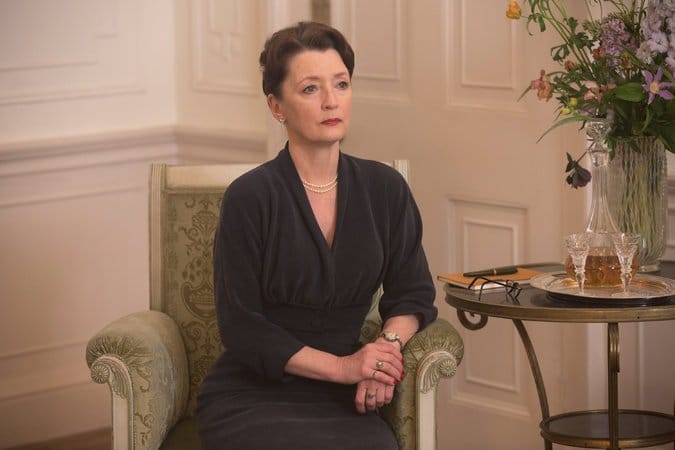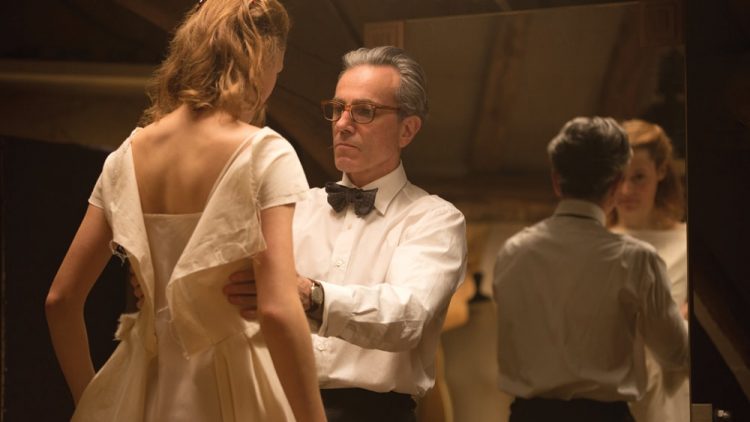Long-time Paul Thomas Anderson collaborator’s work in Phantom Thread is a lot more complex than it gets credit for.
If you told me a couple of months ago that the costumes of Phantom Thread would one day need a defense of sorts, I would have pulled a Reynolds Woodcock: reached for a loaded curse and scathingly looked at you like you rode a horse across the room. Even before Phantom Thread made its initial bow on two coasts late November, the costumes of “a Paul Thomas Anderson film about a 1950s London couturier, by The Artist’s Mark Bridges” read like a safe awards season bet to gamble on. Yet, here we are, just a couple of days after the Costume Designers Guild awarded The Shape of Water designer Luis Sequeria with ‘Excellence in Period Film’ over Phantom Thread’s Mark Bridges. This, at least to me, was a bit of a shock, even during this year’s wildly unpredictable awards cycle, where ‘Best Picture’ still remains a curious question mark, keeping several esteemed Oscar pundits up at night. So a supportive revisit to Mark Bridges’ thoughtful, deeply researched and spot-on work—for both the costumes worn by the film’s various characters in their daily lives and for couturier Reynolds Woodcock’s (Daniel Day-Lewis) fashion creations—on the final days of Oscar voting wouldn’t hurt. (Reminder: AMPAS members will put their pencils down on February 27th, at 5pm PST sharp).

Let me first clarify: this is in no way a swipe at Sequeria’s rich work for Guillermo del Toro’s lovely period fantasy. From Sally Hawkins’ character-defining, standout red coat, to various early 1960s ensembles worn by the entire cast and the costumes of that breathtaking old-Hollywood musical number, his multifaceted and diverse costumes tie numerous facets of The Shape of Water together without a false note. All the same, I’m in favor of Bridges walking away with the big prize on March 4th (and he hopefully will—he’s still the consensus favorite) for a number of reasons. But the guild of costume professionals has spoken, and we should take this result seriously even though it’s nearly impossible to align the CDG outcome with The Oscars (the former has three separate categories for film, consisting of Period, Contemporary and Sci-Fi/Fantasy, whereas AMPAS only has one). So this is my plea to AMPAS to look at the costumes of Phantom Thread as more than a collection of pretty designer dresses. There is a lot more to the breadth of Bridges’ achievement in this film than meets the eye.

I simply adore Phantom Thread’s costumes in the way they display both a superior level of craftsmanship and tempered character development, but perhaps this is a good time to remember that not everyone is thrilled by the creations of ‘The House of Woodcock’. In some reviews and through telling twitter chatter, I noticed that the film’s fashion was found a bit too rigid (and somewhat safe and boring, too), unlike, say, the signature designs of Cristóbal Balenciaga and Charles James; two designers that are often cited as inspirations for Phantom Thread. First, allow me to speculate that ‘rigidity’ was precisely the point Bridges was trying to make with the fashion of The House. Considering how particular and set-in-his-ways Reynolds is (he puts great emphasis on his breakfast rituals and is particular about his asparagus, for instance), it makes sense that his severity that jails the co-habitants of his house would also restrain his designs, the compilation of which unmistakably represents a singular point-of-view. In other words, kudos to Bridges, Phantom Thread’s ‘The House of Woodcock’ costumes unmistakably represent the authorship of Reynolds Woodcock. It’s then no wonder that Bridges kept referring to Day-Lewis as ‘Reynolds’ when I interviewed him for Variety recently—he successfully imagined and treated him as the creator. Reynolds’ alienating tautness (which doesn’t lessen the beauty of his work, but makes it somewhat inaccessible) is subtly evident on a number of garments, including the royal-esque, caped pink and lavender gown he designs for Henrietta Harding, one of his top Clients (the first, establishing garment we see in the film), the wedding dress he later crafts for a princess (which, in his poisoned and vulnerable state, he exaggeratedly calls “ugly”—a decisive touch that makes Reynolds face his creative austerity) and the cap-sleeved floral tea-length dress (one of the most textbook 50s-silhouettes we see in the film) he fits on his muse Alma (Vicky Krieps) to her extreme distaste. (I agree with Alma on this one). When I watched the film at its first New York screening late November (with Paul Thomas Anderson, Vicky Krieps, Daniel Day-Lewis and Lesley Manville in attendance for a Q&A), I was overwhelmed by the beauty of Reynolds’ designs, but I ultimately (and ironically), did not see myself in any of them. I now realize that their purposely-distancing quality (like Reynolds himself) was the reason. It’s no coincidence that I included the spectacularly-tailored power wiggle-dresses of Cyril (Lesley Manville) in my year-end costumes roundup, instead of one of the House’s creations.

I will also add that Balenciaga and Charles James are over-used and misleading as creative references to this film. And I am not making this up. During the same Variety interview I conducted with Bridges, he told me that while they included nods to both designers here and there (e.g. in the above still, Reynolds fits his own test toile in the rare tradition of Balenciaga), the works of the two designers weren’t necessarily in the DNA of The House. “My work is very specific to time and place,” Bridges told me, referring to Reynolds’ contemporaries like Norman Hartnell, Hardy Amies, Michael Sherard, John Cavanagh, Digby Morton and Victor Stiebel as researched inspirations to reflect London’s flavor of the time. This confirmed what Day-Lewis and Paul Thomas Anderson said during the aforementioned Q&A: that Balenciaga came in as a later factor, and was not the starting point. (The duo cited the same group of designers as inspirations). The team knowingly didn’t follow a sculptor-like route imitating Balenciaga or a more flamboyant one, mimicking James. In the same Q&A, Anderson indicated that they made a decision to not make Reynolds Woodcock ‘the best of the best’ in fashion. A clue to this deliberate artistic decision is given in the film when Henrietta Harding leaves ‘The House of Woodcock’ for another designer who is considered ‘chic’ (a word Reynolds detests, but Bridges supports and uses, as he told me.) In my own review of the film, I wondered whether he was destined to have a lasting legacy as a designer, specifically because of this scene.

Phantom Thread is a phenomenal costume film even outside of Reynolds’ fashion designs. I have already swooned over Cyril’s impeccably-fitted dresses that establish her as the no-nonsense power figure that she is. But Bridges’ pitch-perfect work on the English Countryside costumes of Reynolds and Alma is also worthy of praise, even though the soft, cozy silhouettes and UK-sourced woolens worn by both (as Bridges remarked in my aforementioned interview) live in the visual shadow of The House’s lace overlays and draped taffetas. I would argue the red dress Alma wears to her first date with Reynolds is simply a breathtaking costume moment for her warm, approachable yet unapologetically confident character, for which Mark Bridges deserves all the credit in a film filled with an infinite amount of attention to detail. I sincerely hope AMPAS agrees.

The article ‘Phantom Thread’ Costume Designer Mark Bridges Deserves His Second Oscar appeared first on Film School Rejects.


0 comments:
Post a Comment